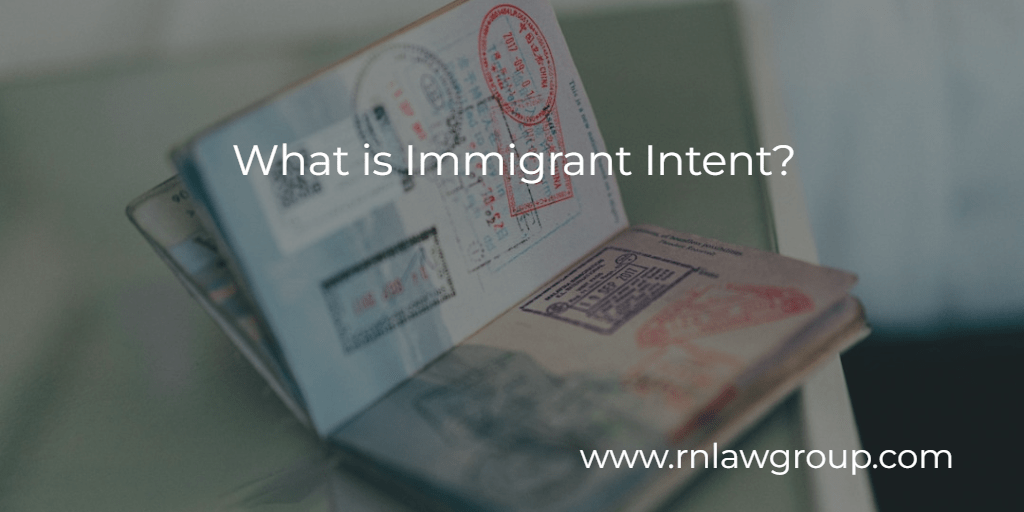
What is Immigrant Intent?
Within the universe of available immigration visas to the United States, we can easily separate those spheres between non-immigrant visas and immigrant visas. The key distinctions between non-immigrant and immigrant visas is 1) what you legally do while in the United States on that visa and 2) how long you can remain in the United States pursuant to your visa documents.
Immigrant visas, also known as Green Cards or Lawful Permanent Resident Status, typically allow an individual to do what a US citizen can do absent the right to vote or duty to serve on a jury. Take that with a grain of salt, but by this we mean a Green Card holder can take any job of their choosing, live anywhere in the country they choose, take as many jobs as they choose, study where they want, etc. Once a Green Card aka immigrant visa is granted to an individual, that individual can remain in the United States for as long as they choose. Additionally, the Green Card is often the only pathway to citizenship, despite what you might hear in the media.
Non-immigrant visas are available for a number of purposes. Name a letter of the alphabet and there’s likely a visa “connected” to that letter. For instance, B-visas are for tourists, F-visas are for students, H- visas are for those in high-value occupations, L-visas for intracompany transferees from abroad, O-visas for those with extraordinary abilities, TN-visas for Canadians/Mexicans with advanced degrees, and so forth.
Each of these visas has a very limited scope in terms of what the foreign individual is entitled to do while in the United States. For B-visa tourists, you can only be a tourist. For F-visas, you can only study and can rarely work. For H-visas, you are likely tied to one employer, in one job, in one geographic locality. For L-visas, you are similarly tied to one employer and likely one job. Long story short, if you’re coming to the United States on a non-immigrant visa, your “freedom” to do as you choose is rather limited. If you engage in an activity outside the scope of your non-immigrant visa, you will have violated US immigration laws and opened up a Pandora’s box of potential issues.
Furthermore, these non-immigrant visas will almost always be limited in duration. B-visas are typically only good for six months at a time. F-visas are only valid so long as the individual is still in their approved course of studies. H- and L-visas are typically only valid for 6 and 5 years, respectively. Conversely, immigrant visas are valid indefinitely.
Apart from knowing what an individual can do on their visa and how long they’re entitled to remain in the United States, it is crucially important that Aliens understand the concept of immigrant intent. Essentially, immigrant intent means “do you have plans to remain in the United States longer than your visa allows”, either lawfully through pursuit of a Green Card or unlawfully through a lapse in immigration status. If the government believes you have an immigrant intent where you are not allowed to have one, it can result in the denial of your visa, your deportability, or your inability to adjust status and/or enter the United States..
Immigration intent can be relevant at two stages: 1) the initial visa issuance at the consulate and 2) any entry into the United States with a non-immigrant visa. Essentially, an Alien must convince the US government that the Alien will either return home or is not presenting facts to otherwise circumvent immigration law. This second notion is not an issue of fraud or misrepresentation; it’s an issue of “preconceived intent”.
One of the most important distinctions in immigration law is an expression of immigrant intent. We know that certain visa categories allow for “dual intent” meaning the visa holder can enter the U.S. with the intention of possibly becoming an immigrant in the future while other visa categories are “singular intent” meaning the Alien must prove an intent to return to their home country after their temporary stay in the U.S.
Visa categories that permit dual intent include but are not necessarily limited to:
- H-1B (Specialty Occupations)
- L-1 (Intracompany Transferees)
- O-1 (Individuals with Extraordinary Ability or Achievement)
- K (Fiancé/Fiancée of U.S. Citizen)
Most nonimmigrant visas do not permit dual intent and require the applicant to demonstrate they intend to return to their home country after their temporary stay in the U.S. These include but are not necessarily limited to:
- B-1/B-2 (Business/Tourist)
- F-1 (Student)
- J-1 (Exchange Visitor)
- TN (Trade NAFTA)
Applicants for these visas must show ties to their home country, such as employment abroad, property abroad, family ties, or other commitments, to prove their intent to return.
Ultimately, we have to ask “what is an expression of immigrant intent?” By and large, the answer to that is “have you filed an immigrant visa Form I-130/I-140 or not?” Depending upon how you answer this question will be the touchstone to your general immigration prospectus.
Does this mean that no-one entering on a singular intent non-immigrant visa will be barred from obtaining a Green Card? When can individual express immigrant intent?
One of the most beautiful things about the United States is that people from around the world still come here for economic opportunity and personal freedom. We would be kidding ourselves if we think every individual coming to the United States on a non-immigrant visa would not jump at the change of obtaining an immigrant visa also known as a Green Card.
USCIS and the Department of State have developed a “90 day rule” to determine if a nonimmigrant visa holder misrepresented their intent upon entering the United States, particularly when they engage in activities inconsistent with their visa status within 90 days, such as marrying a U.S. citizen or applying for adjustment of status to become a permanent resident. Part of the Foreign Affairs Manual (FAM), this rule helps consular officers assess if the applicant had a preconceived intent to immigrate, violating their visa terms. Activities considered inconsistent with nonimmigrant status include unauthorized employment, enrolling in school without authorization, marrying a U.S. citizen, and filing for adjustment of status. If such activities occur within 90 days of entry, there is a presumption of misrepresentation, placing the burden on the visa holder to provide evidence that they did not intend to violate their visa status. This evidence might include unforeseen job offers or sudden changes in personal circumstances. After 90 days, there is no automatic presumption of misrepresentation, but USCIS or consular officers may still investigate the individual’s intent at the time of entry based on the overall circumstances.
Generally speaking, if you enter on a singular-intent non-immigrant visa and wait at least 90 days from your last entrance to the United States on that visa, USCIS will not likely take issue with filing a Green Card. For more information, or for a detailed conversation regarding any questions or issues regarding immigrant intent, the Labor Certification, I-140, and/or I-485 Green Card process, I invite you to schedule a time to speak here.
By : Ryan A. Wilck, Partner and Attorney at Law
Ryan Wilck is a Managing Partner and attorney at Reddy & Neumann, P.C. with over a decade of US immigration law experience, enthusiastic and proactive in his approach assisting clients and their employees through the various phases of the permanent residency a/k/a Green Card process. “Concilio et labore” is not only the motto of Ryan’s favorite sports club but is also his life’s motto; all things come through wisdom and effort. Ryan is passionate about gaining the trust of his clients by utilizing a relentless and detail-oriented approach to understand their specific goals and concerns, hoping to instill a sense of confidence and stability. Whatever your immigration problem or interest, he and his team will find a solution, through wisdom and effort. Reddy & Neumann, P.C. has been serving the business community for over 20 years and is Houston’s largest immigration law firm focused solely on employment-based business immigration. We work with employers and their employees, helping navigate the complex immigration process efficiently and cost-effective.
We are committed to assisting our clients with navigating the complex PERM Labor Certification (ETA 9089 and other challenging immigration matters as an accomplished immigration law firm in Houston, Texas. Our team is here to offer the direction and support you require, whether you’re a company trying to hire top talent or a foreign worker seeking to develop a career in the United States. To find out more about how we can help you with your immigration issues, get in touch with us right away.

